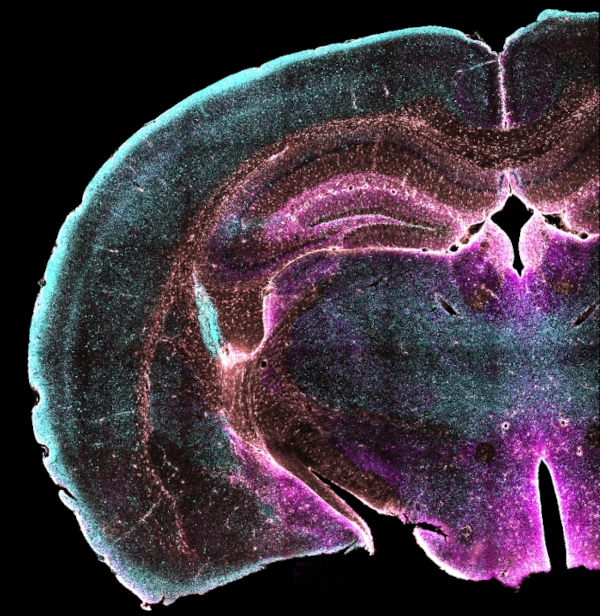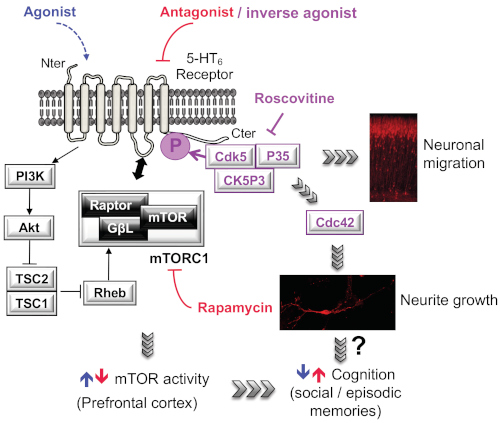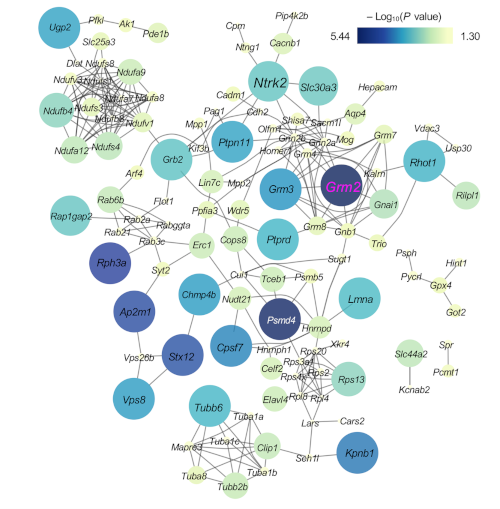Team Philippe MARIN
Neuroproteomics and signalling of brain disorders
Project Interactomics and neuropathologies
PRINCIPAL INVESTIGATOR

IGF staff involved
Carine BÉCAMEL
MCU-HC UM
Séverine CHAUMONT-DUBEL
MCU-HC UM
Franck VANDERMOERE
DR2 CNRS
Sonya GALANT
IECN CNRS

Growing evidence indicates that signal transduction by G protein-coupled receptors (GPCRs) involves large receptor-associated protein complexes. Accordingly, functional studies of GPCRs cannot solely focus on the receptor protein, but must also take into consideration the associated networks of proteins. These networks therefore need to be characterized at the molecular level, an issue we address thanks to interactomic studies based on mass spectrometry. In recent years, we have focused on the interactome of the serotonin 5-HT6 receptor, the glutamate mGlu2 receptor and the chemokine CXCR4 and ACKR3 receptors.
Signaling complexes associated with the oncogenic chemokine receptors CXCR4 and ACKR3
Signaling complexes associated with the serotonin 5-HT6 receptor
Signaling complexes associated with the glutamate mGlu2 receptor
Signaling complexes associated with the oncogenic chemokine receptors CXCR4 and ACKR3
This project, developed within the framework of an ITN (European doctoral network) which has been renewed once, aims to decipher the signaling mechanisms triggered by two chemokine receptors involved in cancer, CXCR4 and ACKR3. The team’s role in the project is to characterize the interactome of the two receptors at molecular and functional levels. The team has demonstrated that the interaction of CXCR4 with Ephrin b1 and the association of ACKR3 with connexin 43, a GAP junction protein, could contribute to the respective oncogenic effects of the two receptors and constitute potential therapeutic targets.

Colocalization of ACKR3 receptor and Connexin 43 (partner identified by interactomics) in mouse brain astrocytes. ACKR3 (cyan), Cx43 (pink), GFAP (yellow). Adapted from Fumagalli et al. Nat. Commun. 2020.
Main publications
• Rabbito A., et al. (2024) BioRxiv, 2024.07.10.602459.
• Fumagalli A., et al. (2020) Nature Communications, 11, 4855
• Fumagalli A., et al. (2019) Mol. Pharmacol., 96, 794.
• Neves M., et al. (2019) Mol. Pharmacol., 96, 819
Funding
• 2015-2019 H2020-MSCA-ITN-2014 ONCOgenic GPCR Network of Excellence and Training (ONCORNET)
• 2020-2024 H2020-MSCA-ITN-2019 ONCORNET2.0
Collaborations
• Martine Smit (Amsterdam, Pays-Bas)
• Federico Mayor (Madrid, Espagne)
• Andy Chevigné (Luxembourg)
• Françoise Bachelerie (Saclay, France)
Alumni
• Alessandro Rabitto (PhD, 2020-2024)
• Amos Fumagalli (PhD, 2015-2019)
Signaling complexes associated with the serotonin 5-HT6 receptor
The serotonin 5-HT6 receptor is expressed early during neurodevelopment, and plays a key role in neurodevelopmental processes (neuronal migration, neurite growth) and cognitive deficits associated with neurodevelopmental psychiatric disorders and dementia. The signaling pathways involved in these effects remain to be discovered. We are tackling this problem by means of interactomic screens which have enabled us to demonstrate that the receptor activates the mTOR and Cdk5 pathways and their respective roles in the cognitive and neurodevelopmental processes controlled by the receptor.

mTOR and Cdk5 signaling pathways under the control of the serotonin 5-HT6 receptor and their role in neural development and cognition.
Main publications
• Martin P.Y et al. (2020) Prog. Neurobiol. 193,101846.
• Berthoux C. et al. (2020) EMBO Mol. Med. 12, e10605.
• Pujol C. et al. (2020) Sci. Signal. 13, eaax9520.
• Deraredj et al., (2016) PNAS. 113, 12310-12315.
• Jacobshagen et al. (2014) Development 141, 3370-7.
• Duhr F. et al. (2014) Nat Chem Biol. 10, 590-7.
• Meffre J. et al. (2012) EMBO Mol. Med. 4, 1043-56.
Funding
• 2022- ANR Contact_5-HT
• 2020-2022 ANR SERO6PAIN
• 2018-2021 ANR SERO6DEV
• 2017-2021 ANR STOPSERO6TOR
• 2016-2018 FRM – CS + PhysiopathAddiction
• 2011-2015 ANR SERO6COGNET
Collaborations
• Mark Millan (Croissy-sur-Seine)
• Kevin Fone (Nottingham, UK)
• Séverine Morisset-Lopez (Orléans)
• Pawel Zajdel (Kraków, Pologne)
• Rafael Maldonado (Barcelone, Espagne)
• Alexandre Dayer (Genève, Suisse)
• Christine Courteix (Clermont-Ferrand)
• Evgeni Ponimaskin (Hannover, Allemagne)
Alumni
• Vincent Dupuy (Thèse, 2018-2022)
• Angélina Rogliardo (Thèse, 2017-2021)
• Coralie Berthoux (Thèse, 2013-2017)
• Camille Pujol (Thèse, 2014-2018)
• Fanny Duhr (Thèse, 2011-2015)
• Julie Meffre (Thèse, 2008-2012)
Signaling complexes associated with the glutamate mGlu2 receptor
The mGlu2 glutamate receptor is a promising target for new antipsychotics (receptor agonists and positive allosteric modulators). However, the signaling mechanisms triggered by the receptor and underlying the effects of glutamatergic antipsychotics remained largely unknown. An interactomic screen based on receptor-specific nanobodies enabled us to demonstrate its association with the BDNF receptor TrkB and the SIK3 protein kinase. We also demonstrated that transactivation of the TrkB receptor by mGlu2 contributes to the effects of glutamatergic antipsychotics in a preclinical model of schizophrenia.

Protein-protein interactions within the mGlu2 receptor (Grm2) interactome. TrkB receptor: Ntrk2. Adapted from Philibert CE, Sci Adv. 2024.
Main publications
• Philibert C.E. et al. (2024) Sci Adv. 10, eadg1679.
• Murat S. et al. (2019) Mol Psy. 24, 1610-1626.
Funding
• 2021-2025 ANR Nano4Schizo
• 2021-2025 ANR SchizoGlu
Collaborations
• Evi Kostenis (Bonn, Allemagne)
• Giuseppe Battaglia (Pozzilli, Italie)
• Ferdinando Nicoletti (Rome, Italie)
• Emmanuel Bourinet (Montpellier)
• Philippe Rondard et Jean-Philippe Pin (Montpellier)
Alumni
• Clémentine Philibert (Thèse, 2018-2022)
• Samy Murat (Thèse, 2014-2018)


